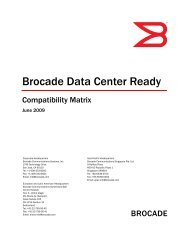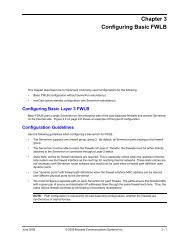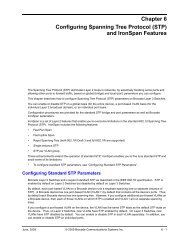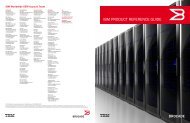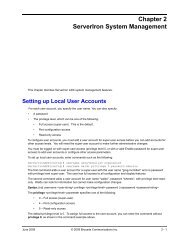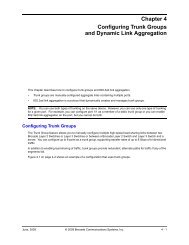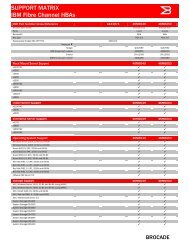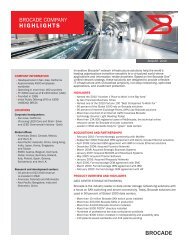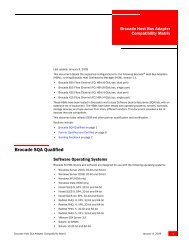Chapter 3 Stateless Server Load Balancing - Brocade
Chapter 3 Stateless Server Load Balancing - Brocade
Chapter 3 Stateless Server Load Balancing - Brocade
You also want an ePaper? Increase the reach of your titles
YUMPU automatically turns print PDFs into web optimized ePapers that Google loves.
Configuring the <strong>Stateless</strong> Hash Table Size<br />
You can configure the size of the stateless hash table as shown in the following:<br />
<strong>Server</strong>Iron(config)#server real R1 10.10.10.1<br />
<strong>Server</strong>Iron(config-rs-R1)#server stateless-hash-table-size 1024<br />
Syntax: [no] server stateless-hash-table-size <br />
<strong>Stateless</strong> <strong>Server</strong> <strong>Load</strong> <strong>Balancing</strong><br />
The variable can be set to any of the following values: 256, 512, 1024, 2048, 4096, or 8192.<br />
The default value is 256.<br />
Configuring a <strong>Stateless</strong> Application Port<br />
To configure an application port to be stateless, enable the stateless parameter on the port in the virtual server.<br />
Here is an example:<br />
<strong>Server</strong>Iron(config)#server real R1 10.10.10.1<br />
<strong>Server</strong>Iron(config-rs-R1)#port http<br />
<strong>Server</strong>Iron(config-rs-R1)#exit<br />
<strong>Server</strong>Iron(config)#server real R2 10.10.11.1<br />
<strong>Server</strong>Iron(config-rs-R2)#port http<br />
<strong>Server</strong>Iron(config-rs-R2)#exit<br />
<strong>Server</strong>Iron(config)#server virtual-name-or-ip <strong>Stateless</strong>HTTP 192.168.4.69<br />
<strong>Server</strong>Iron(config-vs-<strong>Stateless</strong>HTTP)#port http stateless<br />
<strong>Server</strong>Iron(config-vs-<strong>Stateless</strong>HTTP)#bind http R1 http<br />
<strong>Server</strong>Iron(config-vs-<strong>Stateless</strong>HTTP)#bind http R2 http<br />
Syntax: [no] port stateless<br />
The parameter specifies the application port you want to make stateless.<br />
Disabling the <strong>Stateless</strong> SLB Hashing Algorithm for UDP Ports<br />
By default, stateless SLB uses a hashing algorithm to select a real server. The <strong>Server</strong>Iron ADX calculates a hash<br />
value for a given client request based on the request’s source IP address and source TCP/UDP port. The request<br />
is sent to a real server corresponding to this hash value.<br />
For UDP connections consisting of one client packet and one server response packet, you can disable the<br />
stateless SLB hashing algorithm. When the stateless SLB hashing algorithm is disabled for UDP ports, the<br />
<strong>Server</strong>Iron ADX uses the round-robin load balancing method to select a real server for the request. In this case,<br />
the <strong>Server</strong>Iron ADX load balances UDP packets destined for the VIP without creating a session and without<br />
calculating hash values based on UDP port number and source IP address.<br />
DNS is an example of a UDP port where this feature can be used. The advantage of disabling the stateless SLB<br />
hashing algorithm is that a new real server can be selected immediately after it is brought up.<br />
For example, to disable the stateless SLB hashing algorithm for the DNS port (UDP port 53), enter commands<br />
such as the following:<br />
<strong>Server</strong>Iron(config)# server virtual-name-or-ip <strong>Stateless</strong> 192.168.4.69<br />
<strong>Server</strong>Iron(config-vs-<strong>Stateless</strong>)# port dns stateless no-hash<br />
Syntax: [no] port stateless no-hash<br />
Configuring a Port To Be Both <strong>Stateless</strong> and Stateful<br />
You can use the stateless option when configuring an application port on a virtual server to make that port<br />
stateless. By default, the port is stateless for both TCP and UDP. You can specify the protocol for which you want<br />
the port to be stateless. For example, you can configure port DNS to be stateless for TCP while remaining stateful<br />
for UDP, by entering commands such as the following:<br />
<strong>Server</strong>Iron(config)# server real R1 10.10.10.1<br />
<strong>Server</strong>Iron(config-rs-R1)# port http<br />
<strong>Server</strong>Iron(config-rs-R1)# exit<br />
June 2009 © 2009 <strong>Brocade</strong> Communications Systems, Inc. 3 - 3



